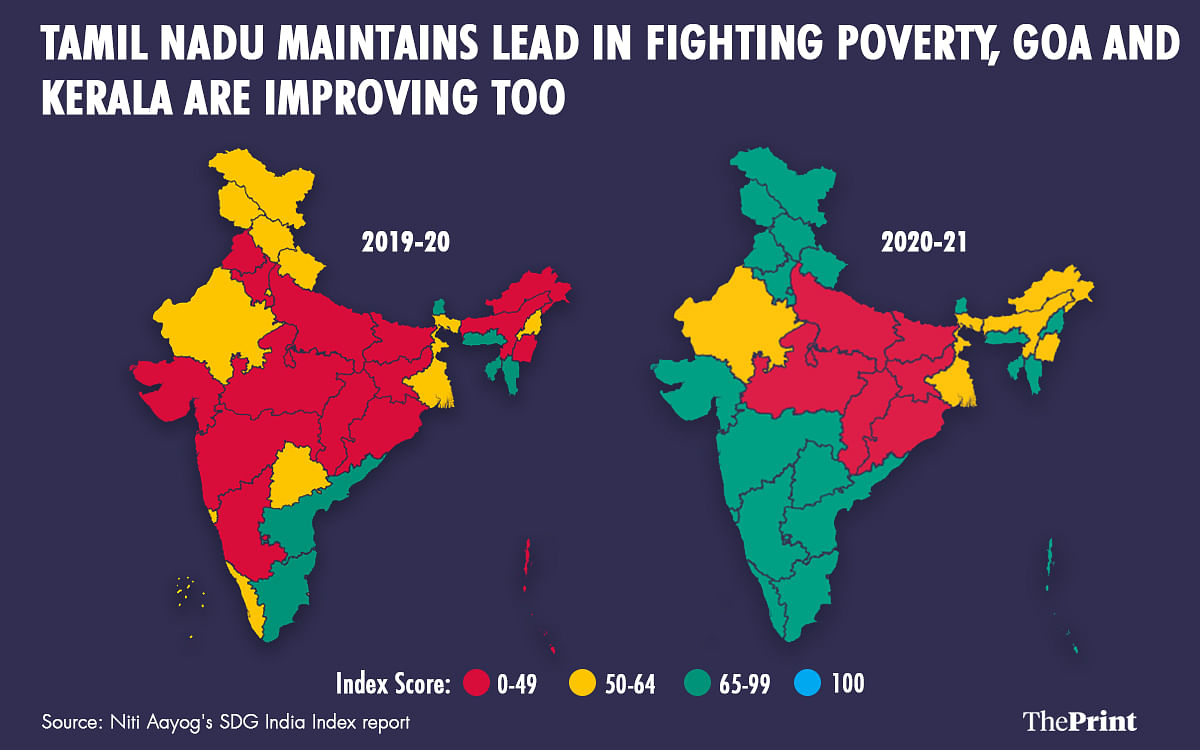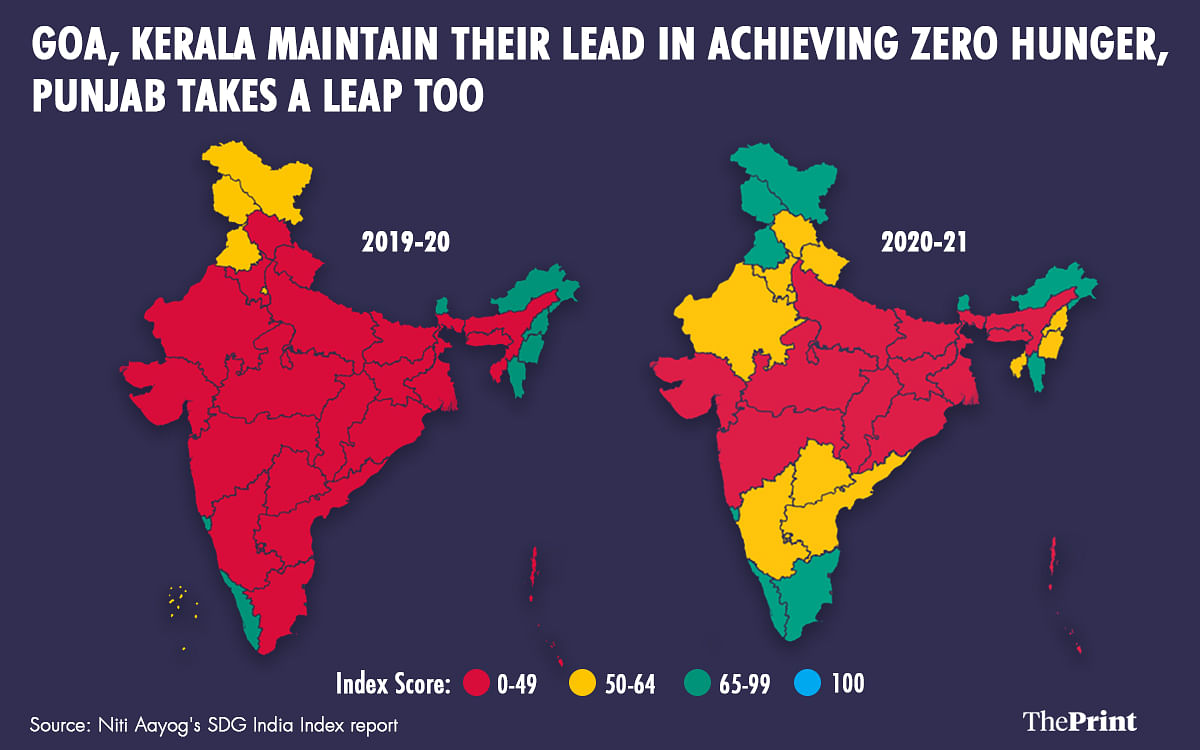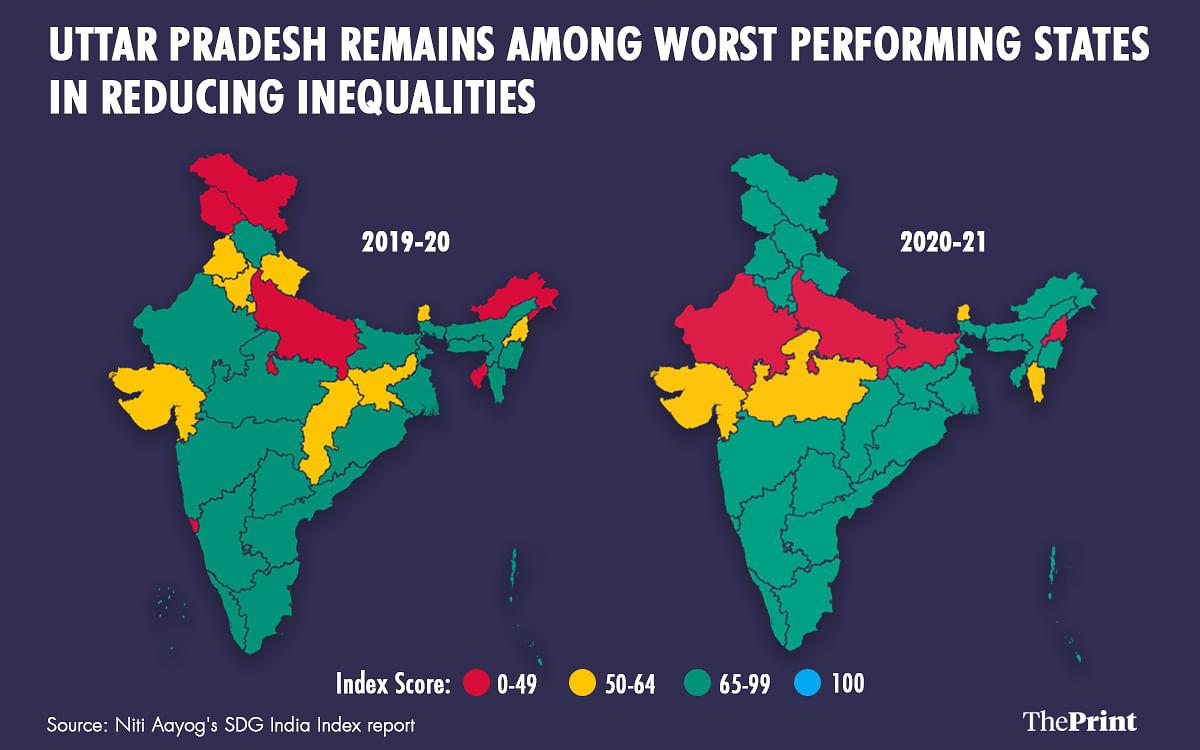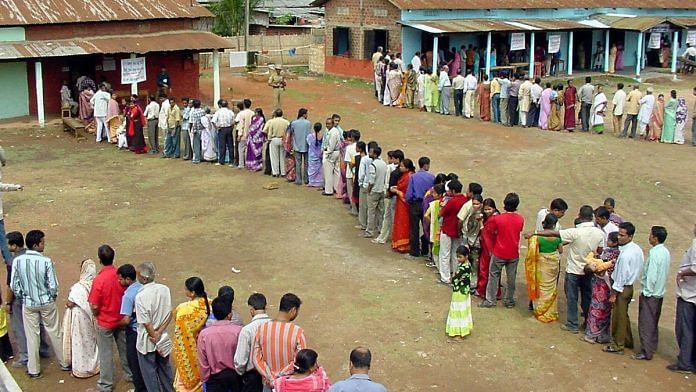New Delhi: India improved its poverty eradication, zero hunger and reduced inequality scores in 2020-21 over the previous fiscal, according to Niti Aayog’s latest sustainable development goals (SDG) index.
On poverty eradication, India improved its index score to 60 in 2020-2021 from 50 in 2019-2020. The score for zero hunger went up to 47 from 35 even as it continues to be an area of concern. On reduced inequality, the country went up three points, to 67 from 64.
Here’s a look at what the Niti Aayog report reveals about these three SDGs. The report was published last week.
Also read: State of the states: NITI report shows who’s rising, who’s lagging and the gap in between
On poverty eradication
Eradicating poverty “in all forms and dimensions” is the primary SDG. According to the latest index, Tamil Nadu tops the list with a score of 86 followed by Goa and Kerala, both at 83, and the national capital at 81.
Bihar, Jharkhand and Odisha are the worst performing states with an index score of 32, 36 and 41, respectively.
India’s score of 60 is based on six indicators.
- Six states and seven union territories (UTs) have 10.96 per cent of the population living below the poverty line (BPL)
- Eight states and six UTs have a 13.95 per cent or more head count according to the multidimensional poverty (several disadvantages at the same time)
- No state has managed to provide a member of each household with a health scheme or insurance
- Two states have provided 98.95 per cent of those who demanded employment under Mahatma Gandhi National Rural Employment Guarantee Act
- No state has provided social protection benefits under Pradhan Mantri Matru Vandana Yojana to all eligible population
- Three UTs have zero percentage of households living in kuccha houses.
These figures, however, may not be entirely accurate given that poverty data has not been calculated since the 2011 Census.
“The BPL list is very controversial as it is because the measures keep changing. We are essentially looking at data that is 10 years old,” Nikhil Dey, founding member of the Mazdoor Kisan Shakti Sangathan, told ThePrint.
He explained that poverty is the single largest factor that connects to starvation. But states like Gujarat, Maharashtra, Karnataka, Telangana and Haryana — which are the front-runners in eradicating poverty — are falling short on the zero hunger goal.

Also read: It’s Tamil Nadu and Kerala again, plus Punjab, that top Modi govt’s school grading index
On zero hunger
This goal is to ensure no adult or child goes hungry and has access to nutritious food by 2030.
It can be achieved by “promoting sustainable agriculture, supporting small-scale farmers and equal access to land, technology and markets”, the report said.
Kerala tops the list with an index score of 80, followed by Goa at 78 and Punjab at 73. The worst performing states are Jharkhand, Bihar and Meghalaya at 19, 31 and 37, respectively.
While Tamil Nadu topped the poverty eradication index, it fell to the seventh slot in reaching zero hunger.
But Dey believes the state is doing well for itself. “Its good performance is significant because it shows what other states of its size could do. One would expect this from Kerala, because it has for years had a very good social sector framework,” he explained.
Dey is also of the opinion that Meghalaya’s ranking doesn’t make sense. “We have done social audits there; it has a society that does a lot for each other. It’s a myth that the Northeast doesn’t have good government services. Mid-day meals, public health centres were much better in the Northeast than other parts of India,” he said.

The country’s average stands at 47. This is based on seven indicators.
- Twelve states have achieved the target of covering 99.51 per cent beneficiaries under the National Food Security Act 2013
- No state or UT has managed to bring down the percentage of children younger than five who are underweight and stunted to 1.9 and 6 per cent, respectively
- Four states have recorded equal to or less than 25.2 per cent of anaemic pregnant women aged 19-49
- Only two states have achieved the target set (14.2 per cent) for anaemic adolescents of 10-19 years
- No state has managed to produce the target amount of rice and wheat (2995.21 kg/ha)
- Six states have surpassed the target level (1.22) for gross value added in agriculture per worker.
Also read: Gender gap in vaccine worse than India’s sex ratio: Only 867 women got Covid shot per 1,000 men
On inequality
India’s 10th SDG is reduced inequalities, both income and outcome — the former means salary while the latter pushes for “equal opportunities and promoting social, economic and political inclusion of all, irrespective of age, sex, disability, race, ethnicity, origin, religion or economic or any other status relevant within a society”.
Meghalaya tops the list with an index score of 88, followed by Tripura at 85 and Himachal Pradesh at 78. Uttar Pradesh, Rajasthan and Nagaland with a score of 41, 45 and 46, respectively, are the worst performing states.

The country’s average stands at 67. This is measured based on seven indices.
- Three UTs and one state have achieved or surpassed the target of 4.67 per cent of population in the lowest two wealth quintiles
- No state or UT has managed to come close to the goal of 50 per cent elected women in the Lok Sabha elections
- Only Dadra and Nagar Haveli and Mizoram have failed to reach the goal of 33 per cent seats held by women in Panchayati Raj Institutions
- Five states have achieved the 1:1 ratio of transgender to male Labour Force Participation Rate (+15 years)
- North-eastern states of Tripura, Meghalaya, Mizoram and Manipur have reported zero crimes against SCs (per 1,00,000)
- Arunachal Pradesh, Meghalaya, Nagaland, Dadra and Nagar Haveli, Daman and Diu, Jammu and Kashmir, Ladakh and Lakshadweep have reported zero crimes against STs (per 1,00,000).
What experts say
Professor Himanshu, who teaches economic studies at the Jawaharlal Nehru University, told ThePrint that he is not surprised by the best and worst performing states.
“That happens simply because in the top three states, the society is much better and women have a much better position. The bottom states, the situation women live in is not good and the SC/STs population is also much higher,” he said.
“There is a subjective opinion on what indicators to choose. These are broadly acceptable, but there are several factors one looks at such as wages, access to education, health, the economy etc. There lacks a concrete consensus on what indicators should be looked at,” he said.
In the 2019-2020 report, 17 indices were monitored to calculate reduced inequality. That figure is down to seven this year.
Some of the metrics that were dropped include growth rates of household expenditure per capita among the bottom 40 per cent of the population in rural/urban India, Gini Coefficient of household expenditure in rural/urban India, percentage of tribal sub-plan fund utilised and percentage of scheduled caste sub plan fund utilised.
On the missing income inequality metrics, he said, “Ideally, one should stick to a consistent list of indicators”.
Also read: Sub-African India: Much of Africa is richer than us, has better indicators, while we diminish



